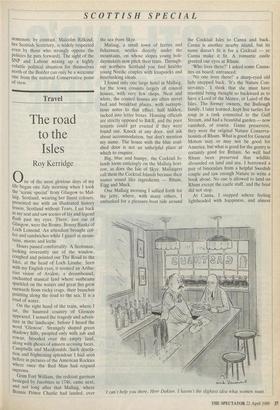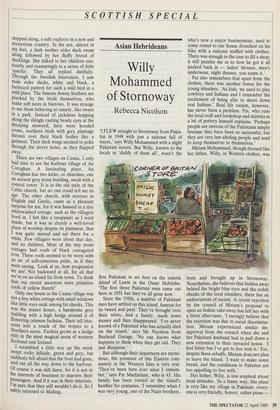Travel
The road to the Isles
Roy Kerridge
One of the most glorious days of my life began one July morning when I took the 'scenic special' from Glasgow to Mal- laig. Scotland, wearing her finest colours, Presented me with an illustrated history lesson, Scotland without Tears. I sat back in my seat and saw scenes of lay and legend flash past my eyes. There, just out of Glasgow, were the Bonny, Bonny Banks of Loch Lomond. An attendant brought cof- fee and sandwiches while I gazed at moun- tains, moors and lochs.
Hours passed comfortably. A Scotsman, looking reverently out of the window, Coughed and pointed out The Road to the Isles, at the head of Loch Linnhe. Seen With my English eyes, it seemed an Arthu- rian vision of Avalon, a dreambound, enchanted musical land where sunbeams sparkled on the waters and great firs grew outwards from rocky crags, their branches Pointing along the road to the sea. It is a road of water.
On the right hand of the train, where I sat, the haunted country of Glencoe appeared. I sensed the tragedy and adven- ture in the landscape, before I heard the word 'Glencoe'. Strangely shaped green shadowy hills, peopled only with ash and rowan, brooded over the empty land, along with ghosts of unseen accusing faces, Campbells and Macdonalds. Such desola- tion and frightening splendour I had seen before in pictures of the American Rockies Where once the Red Man had reigned supreme.
Grim Fort William, the redcoat garrison besieged by Jacobites in 1746, came next, and not long after that Mallaig, where Bonnie Prince Charlie had landed, over
the sea from Skye.
Mallaig, a small town of ferries and fishermen, nestles directly under the mountains, on whose slopes young holi- daymakers now pitch their tents. Through- out northern Scotland you find healthy young Nordic couples with knapsacks and freethinking ideals.
I found only one large hotel in Mallaig, for the town consists largely of council houses, with very few shops. Neat and white, the council houses are often secret bed and breakfast places, with surrepti- tious notes to that effect, half hidden, tucked into letter boxes. Housing officials are strictly opposed to B&B, and the poor tenants could get evicted if they were found out. Knock at any door, and ask about accommodation, but don't mention my name. The house with the blue coal- shed door is not an unhelpful place at which to enquire.
Big, blue and humpy, the Cocktail Is- lands loom enticingly on the Mallaig hori- zon, as does the Isle of Skye. Mallaigers call them the Cocktail Islands because their names sound like ingredients — Rhum, Eigg and Muck.
One Mallaig morning I sallied forth for the jetty, where, with many others, I embarked for a pleasure-boat ride around the Cocktail Isles to Canna and back. Canna is another nearby island, but its name doesn't fit it for a Cocktail — ye Canna make it fit. A romantic castle greeted our eyes at Rhum.
'Who lives there?' I asked some Canna- ites on board, entranced.
'No one lives there!' a sharp-eyed old lady snapped back. 'It's the Nature Con- servancy.' I think that she must have resented being thought so backward as to have a Lord of the Manor, or Laird of the Isles. The former owners, the Bullough family, I later learned, kept live turtles for soup in a tank connected to the Gulf Stream, and had a beautiful garden — now vanished, of course. Game preservers, they were the original Nature Conserva- tionists of Rhum. What is good for General Motors may or may not be good for America, but what is good for the gentry is certainly good for Britain. So well had Rhum been preserved that wildlife abounded on land and sea. I borrowed a pair of binoculars from a helpful Swedish couple and saw enough Nature to write a book about. No one is allowed to land on Rhum except the castle staff, and the boat did not stop.
At Canna, I stepped ashore feeling lightheaded with happiness, and almost 'I can't help you there, Herr Doktor. I haven't the slightest idea what women want.'
SCOTTISH SPECIAL
skipped along, a safe explorer in a new and mysterious country. In the sea, almost at my feet, a dark mother eider duck swam along followed by her fluffy brood of ducklings. She talked to her children con- stantly and reassuringly in a series of little `querks'. They all replied dutifully. Through the Swedish binoculars, I saw male eider ducks, white and black, a farmyard pattern for such a wild bird in a Wild place. The famous downy feathers are plucked by the birds themselves, who make soft nests in burrows. It was strange to see them behaving so tamely, like swans In a park. Instead of jackdaws hopping along the shingle casting beady eyes at the decaying seaweed, here were hooded crows, northern birds with grey plumage thrown over their black bodies like a garment. Their dark wings seemed to poke through the sleeve holes, as they flapped away.
There are two villages on Canna. I only had time to see the harbour village of An Coroghan. A fascinating place, An Coroghan has two kirks, or churches, one an ancient grey stone building, small with a conical tower. It is in the old style of the Celtic church, but no one could tell me its age. The other church, with services in English and Gaelic, came as a pleasant surprise for me, for it was housed in a tiny Whitewashed cottage, such as the villagers lived in. I felt like a trespasser as I went inside, but it was so clearly a well-loved place of worship despite its plainness, that I was quite moved and sat there for a While. Few villagers were about that day, and no children. Most of the tiny stone cottages had roofs of black corrugated iron. These roofs seemed to be worn with an air of self-conscious pride, as if they were saying, 'Look at us, how progressive we are! Not backward at all, for all that we're on an island far from town. To think that our recent ancestors were primitive roofs of yellow thatch!'
Only one house in the Canna village was not a tiny white cottage with small windows like little eyes sunk among fat cheeks. This was the manor house, a handsome grey building with a high hedge around it of flowering crimson fuchsias. Their tall blos- soms lent a touch of the tropics to a Northern scene. Fuchsia grows as a hedge only in the most magical areas of western Scotland and Ireland.
I scrambled a little way up the wind- swept rocky hillside, green and grey, but suddenly felt afraid that the boat had gone, and ran all the way down to the harbour. Of course it was still there, for it is not in the interests of boatmen to maroon their Passengers. And if it was in their interests,
m sure that they still wouldn't do it. So I safely returned to Mallaig.



































































 Previous page
Previous page